Foreign Insulators
by Marilyn Albers
Reprinted from "Crown Jewels of the Wire", March 1986, page 23
WILL THE REAL ISOREX "234" PLEASE STAND UP?
The three insulators shown in the photo below are each made of dark green
glass, they each came from France and they are each embossed Isorex/234! Yet
obviously they differ from each other in design! If it were not for our unique
CD numbering system, confusion could very well reign. Let's take a look at them,
one by one.
|
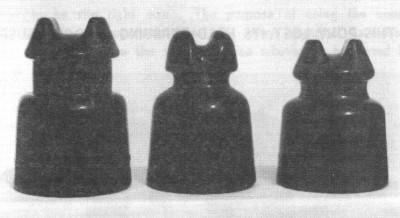
|
| CD 536.2 |
CD 552.4 |
CD 552 |
Left: CD 536.2 Isorex/234 IBS
You'll probably recognize this one from having seen
it in Milholland's book (Most About Glass Insulators) under its former CD number
827. I've also seen identical units marked HC 64 in place of the numbers 234. I
believe this is the way it's listed in Milholland. Same insulator.
Center: CD 552.4 Isorex/234
This insulator is a new find, which is always a
thrill! See how it differs from the other two.
Right: CD 552 Isorex/234
Here again, you will recognize a familiar face. It's the
former CD 829 in Milholland's book and has simply been reassigned to fit into
the separate design chart that has been devised for foreign glass items.
Obviously, the "234" cannot be the style number because each
insulator is different in shape. Perhaps it indicates that all 3 styles could be
used interchangeably on the power line? Or could be progressively newer styles?
None of the three appears to be that old. I honestly don't know!
THIS PONY LOST ITS HEAD PURSUING A GOOD CAUSE
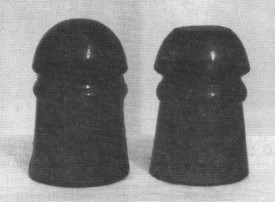
Believe it or not, both of these insulators are (were) identical CD 102
Diamond ponies. Both are in my collection. I bought the one on the right through
the mail without realizing it had a flat dome. It had simply been described as a
CD 102 with Diamond embossing and gave the color. When I first saw it, it looked
to me as if someone had tried to fix the damage by grinding it down, which, of
course, never "fixes" anything! It's just an attempt to fool somebody.
The person who sold me the insulator assured me that it had been in that
condition when he bought it, and considering the source, I believe him.
Several days later, I learned something which made me come to value and
respect this little flat top. I was visiting with another collector (John Hall
of Pearland, TX) who had a CD 102 Brookfield in the same condition. Mr. N. R.
Woodward of Houston happened to be there also, and he offered the following
likely explanation for the ground off appearance of the crown.
First let me say that besides originating the CD numbering system,
"Woody" has always been very interested in anything to do with
railroads. As a little boy he spent a lot of time watching the trains go by, and
liked to sort of hang around the stations and railroad yards to see what he
could learn. He says he can remember seeing the Telegrapher, who operated the
telegraph key, sitting in a chair that had each of its four legs stuck into an
inverted pony insulator, which just happened to be the right size. The purpose
of using the insulators was to insulate the operator from any stray electrical
currents. It certainly could have been the same situation whether it happened in
the U.S.A. or Canada.
When John Hall heard this, he said that when he first acquired his insulator,
it had been painted black, and the pinhole was stuffed with a cotton-like
material. Aha!! The plot thickens! Maybe the paint made the insulators less
conspicuous, and can't you just see how that crown would eventually wear down as
the telegrapher moved his chair back and forth several times a day?
Woody also remembers seeing chunks of wooden cross arms (insulator side down)
on the floor of the phone booths, and people stood on the wood when making a
phone call. The reason was the same; to insulate the caller from any electrical
leakage coming from the telephone. More flat crowns!
Of course, my insulator could have been ground down to hide any damage, but I
prefer to believe that it earned its flat noggin by doing service. It's more
romantic.
Color? I failed to mention the color. You see, my only regret is that, for
their purposes, the folks at the railroad station happened to grab that
particular pony, which was the most vivid shade of teal blue I've ever seen!
It's the rarest color of all those found in the CD 102 Diamonds. How could they
know?
GINGERBREAD MOMMA, WHERE HAVE YOU BEEN?
The Gingerbread family is now complete! I just couldn't believe it when I
found this middle size insulator that falls right between the smallest and the
largest sizes we are all so familiar with. In fact, it is the only one Iíve
ever seen. All three insulators come from France, and as you can see, they are
made of dark green glass. For you new collectors, we call this design of
insulator our "Gingerbread Man" because that's what it looks like! All
three sizes have their own CD numbers, so we can tell them apart, and its fun to
find a new one.
Left to right in the photo below:
Little Gingerbread Boy: CD 640 (former 781) Isorex/ 35/3
Gingerbread Momma: CD
641 (new CD) Isorex/ 221
Large Gingerbread Man: CD 642 (former 783) Isorex/ 35/1
|
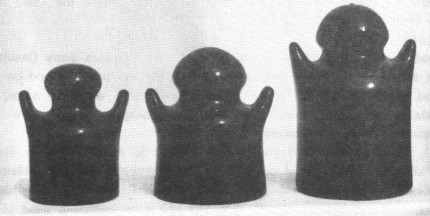
|
|
CD 640
|
CD 641 |
CD 642 |
CRISOL TEXCOCO NO. 9, YOU'RE A CD 121! WRONG, I'M CD 106.5!
In the first photo below, you will see three glass insulators, and maybe you
will be surprised at the CD numbers. Let's take a look.
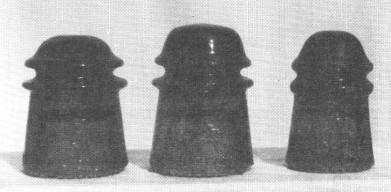 |
| CD 106.5 |
CD 106.5 |
CD 106 |
Left: CD 106.5 Crisol Texcoco/No. 9, in yellow green.
Center: Cd 106.5 Crisol Texcoco/No. 9, in medium green.
Right: CD 106 Hemingray - 9, 7-up green.
Since the two examples of Crisol Texcoco/No. 9's have come to light, and they
are both Mexican insulators, there has been quite a bit of disagreement over
their being given the same CD number, since the difference in depth of crown is
so different. But if you will look closely, you can see that they are identical
up to that point, and therefore there is more argument for their being the same
CD than against.
Collectors have also asked "Why is it close to a CD 106 at all"?
Yes, 106 is some smaller, but not that much. Look at it again. The general slope
of the crown, the rounded wire groove, and the way the lip below the wire groove
comes in as the skirt begins its slope downward; all of these features resemble
the newly dubbed CD 106.5 Crisol Texcoco's.
Now see the 106.5's compared to a CD 121 Hemingray/No. 16 in the following
photo.
|
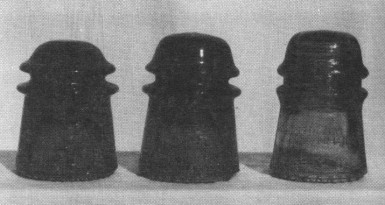
|
| CD 106.5 |
CD 106.5 |
CD 121 |
At first blush, I can see why you would say "that's it!! It's a CD
121". But look again at the real 121 at the right in the photo. Straight
wire groove instead of curved, the crown slopes up more abruptly, and the lower
lip under the wire groove takes its time curving in to join the skirt slope. And
if you were arguing that the 106 was smaller, the 121 is a bit taller!! At any
rate, the Crisol Texcoco/No. 9 will be CD 106.5. Mr. Woodward has assigned this
number, after careful consideration, and close examination of the four examples
shown above. Anyway, please don't lose any sleep over this, because the only
reason a CD number appears in the design chart to begin with, is for
identification purposes.
I do have one bit of additional information from Mike Guthrie (Madera, CA) on
the origin of these Mexican insulators. He says there is actually a record of
there having been a glass factory in the town of Texcoco dating back to 1847. He
thinks it was called Cristslerias de Texcoco. This town borders on the eastern
city limits of Mexico City today. Years ago, there were quite a few miles
between the two towns, but that gap has closed with the growth of Mexico City.
Up until a few years ago, there was an active Texcoco glass factory in the
town of that name, and whether it was the same one as the old record tells about
is not certain, but most likely it is. The Texcoco/No. 9 in the center of the
two photos just preceding actually were taken down from power lines leading into
the glass factory, and no, Mike did not take them down! After all, he is a
policeman, or did you know that? You do now. Mike is a great guy!
| 